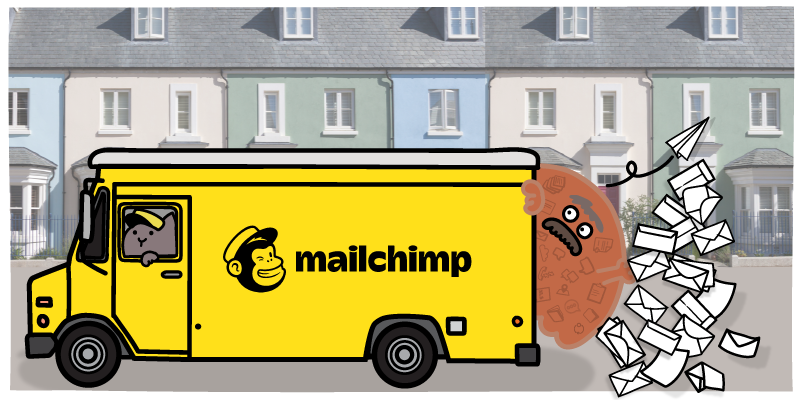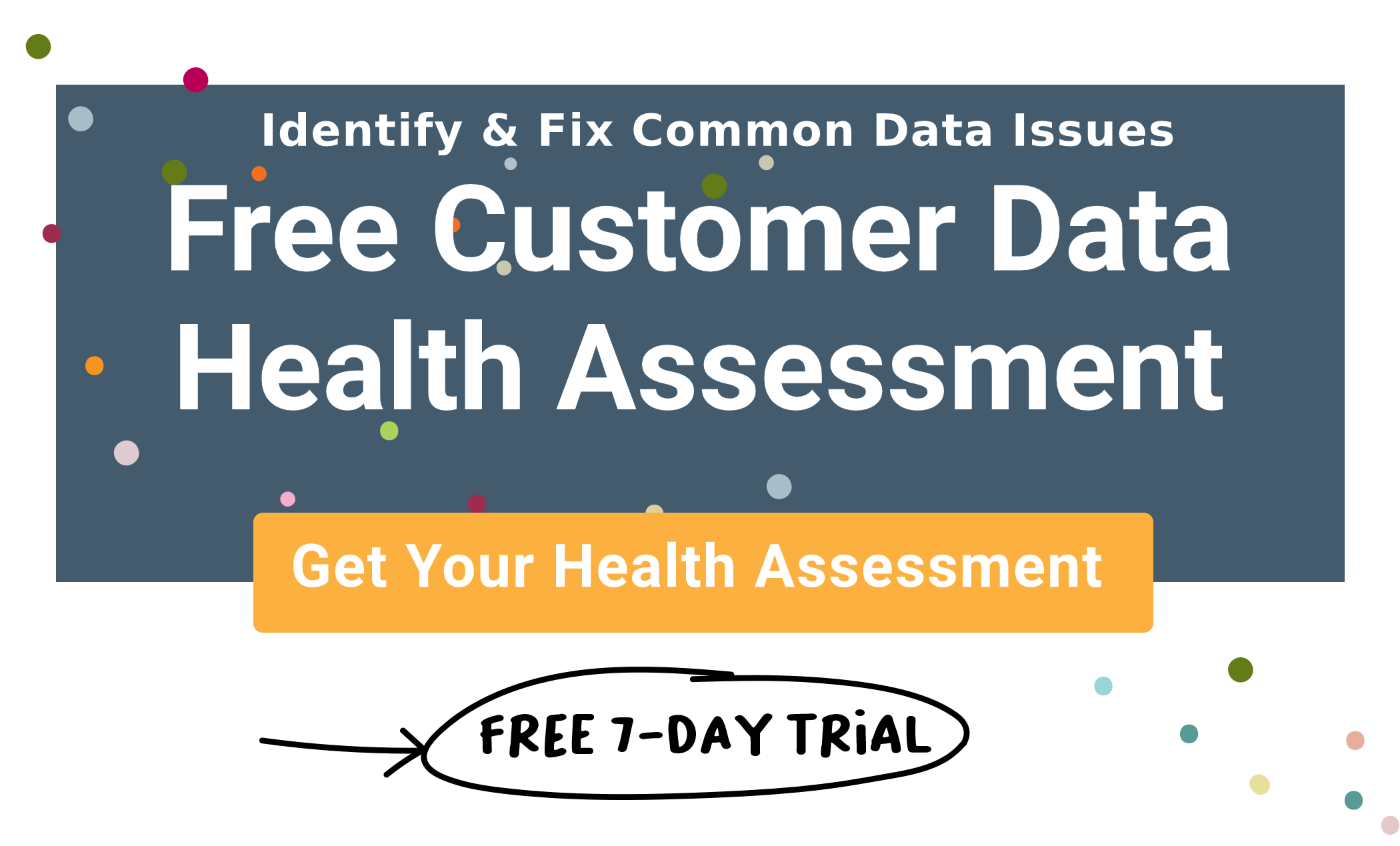You’ve been sending emails out to your growing Mailchimp email list, and now certain contacts within your system are being marked as “cleaned.”
But what does that mean, exactly?
Naturally, one of the first places your mind might jump to when you see ‘cleaned’ is the cleanliness of the data for that contact. It makes sense, since the topic of data cleansing is often referred to as ‘data cleaning.’ But that is not the case.
It can be a bit of a confusing term. What does ‘cleaned’ mean in Mailchimp? In short, it means that the email has bounced on either its last send in the case of a hard bounce, or in several of the last sends, in the case of a soft bounce.
Now, unless you are an expert in email marketing tech, that may not clear things up for you.
Data cleansing refers to the process of preparing your data for use, analysis, and execution within your business. Typically, this involves fixing data that is incorrect, incomplete, redundant, or inconsistent. Data cleansing is not removing and erasing information, but purging garbage data does have an important role to play in your overall data quality strategy.
We’ll dive into the details of data cleansing in Mailchimp in a bit, but first let’s start by breaking down exactly what ‘Cleaned’ means in Mailchimp.
- What Does ‘Cleaned’ Mean in Mailchimp?
- Looking for a Mailchimp Data Cleansing Solution?
- Insycle — A Marketer’s Ally for Cleansed Mailchimp Data
What Does ‘Cleaned’ Mean in Mailchimp?
When an email has been marked as ‘Cleaned’ in Mailchimp, that means that either the last email sent to that address hard bounced or there have been multiple repeated soft bounces in a row.
A hard bounce happens when an email could not be delivered to the intended address for permanent reasons. Those reasons include things like an incorrect or fake email address, an unregistered email domain, or a server refusing to accept the emails due to a security filter. In most cases it makes sense to remove an email that hard bounces from your email list because having high bounce rates on your sends will negatively impact your email reputation, and hard bounced emails are unlikely to ever do anything but bounce on future sends.
A soft bounce is an email that isn’t delivered for reasons that could be temporary. This could be something like an inbox being full, an email being too large, or temporary issues with deliverability. Because of the higher chances that soft bounced emails have issues that are temporary, you typically want to try to mail to them again. However, if those soft bounces keep happening, it is a good idea to discontinue sends to that person. This is essentially what the ‘cleaned’ feature does for you — enforces best practices regarding how to handle bounced emails.
Generally, you want to keep your bounce rate below 2%, or you will start to experience deliverability issues and harm your email sender reputation. Cleaned addresses help to get you there.
So when Mailchimp marks an email as ‘cleaned,' that signals that those emails have been removed from your list due to a single hard bounce, or multiple soft bounces — they are effectively unsubscribed contacts. Those are cleaned contacts. This is a good thing because those are emails that you would likely want to remove from your list no matter what. The email reputation of your domain is nothing to play with.
However, one thing to keep in mind about cleaned contacts in Mailchimp is the fact that typos are guaranteed to hard bounce. For instance, if a contact had entered their email as “jane@acme.com” instead of “jane@acem.com,” the email is likely to bounce. However, you would probably prefer to fix these emails rather than remove them from your email marketing list.
And this issue speaks to the larger issue of data cleanliness and data cleansing in Mailchimp, which might be what you were hoping ‘cleaned’ meant when you saw contacts tagged with that in your Mailchimp account.
Looking for a Mailchimp Data Cleansing Solution?
Were you hoping that ‘cleaned’ in Mailchimp meant something a little different? Maybe referring to the data being cleaned up in some way? Or a simple way to get from messy to cleaned contacts?
If you were, don’t worry. Insycle can help you to cleanse, declutter, and standardize your Mailchimp data to reduce soft and hard bounces, improve personalization, and keep your email marketing sender reputation squeaky clean.
Insycle connects directly to your Mailchimp account — so you never have to export and import the data to work on it — and changes made within Insycle can be pushed directly to your live Mailchimp database.
Let’s take a look at some of the different ways that Insycle can help you to cleanse your Mailchimp data.
Merge Duplicates Automatically, Even Across Audiences
Duplicates can be a huge problem. They cause embarrassing mistakes, such as sending the same email to the same prospect multiple times. Ultimately, that impacts your brand’s reputation with that contact and can hinder the likelihood that they will ever purchase from your company again.
Mailchimp does include some built-in deduplication features. However, Mailchimp matches duplicates only by email. If Mailchimp detects a duplicate email, it will keep the second record from being added to your subscriber list. The one downside of this is that the system only detects exact-match emails, so similar email addresses, or personal and work email pairs, won’t be detected and handled by the system.
Mailchimp also treats separate audiences in your Mailchimp account as different lists entirely. That may make sense in some cases, but companies that use audiences to segment and organize their list may run into the issue of not being able to deduplicate Mailchimp contacts across audiences. That impacts marketing campaigns across your company.
Additionally, when a prospect receives the same email multiple times, they are much more likely to mark it as spam. This hurts the deliverability of your emails and overall sender reputation, impacting email marketing across your organization.
But being marked as ‘spam’ isn’t the only problem here. Low-quality lists with a large number of duplicates lower your open rates, which increases the likelihood of emails landing in the “spam” or “promotional” inbox.
The key metrics that impact your email sender reputation include:
- Open rate. How many of your emails are being opened by your audience? When you send a lot of emails and no one opens them,
- Unsubscribe rate. How many of your recipients unsubscribe when you email them? High unsubscribe rates are used to identify low-quality senders.
- Hard bounce rates. High hard bounce rates can be a sign of sending to low-quality lists or sending to addresses that have not opted in.
More duplicates also means more contacts in your system, which means higher costs as Mailchimp plan pricing is based on the number of contacts.
Insycle can help you to identify and merge Mailchimp duplicates, even across audiences, where Mailchimp usually treats two contacts as different contacts altogether.
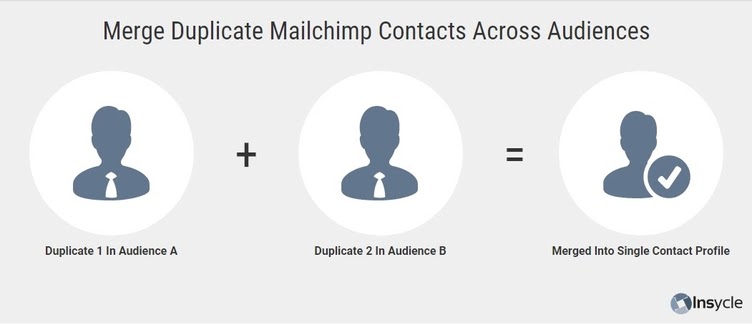
Insycle offers a flexible way to identify duplicates using any data field, not just the email address. Insycle can match duplicate emails using both “exact match” and “similar match” technology, allowing you to surface more duplicates.
Let’s look at an example Mailchimp deduplication template in Insycle:
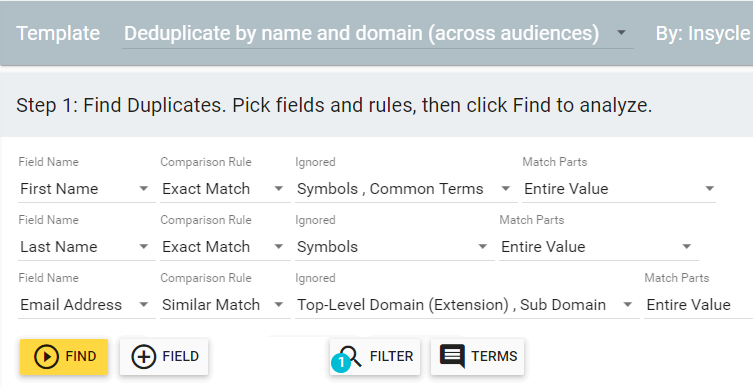
This template identifies duplicates, across audiences, that have the same first name, last name, and email address, while ignoring the subdomain and top-level domain, for example matching jane@acme.com with jane@acme.co.uk and jane@www.acme.com.
This is a great example of how you can combine multiple field variables in Mailchimp to hone in on duplicate contacts that otherwise would have gone undetected.
Cleanse & Standardize Mailchimp Contacts
Messy, disorganized data hurts your ability to personalize your emails, segment and tag your lists, and connect with your audience. Personalization can deliver 5-8x the ROI on marketing spend.
In Mailchimp, there are a few data fields that you need to ensure are clean and standardized to be used as personalization elements in your campaigns.
First is names, and particularly first names. Obviously, you want to call people by their name in your Mailchimp campaigns to add the most basic element of personalization.
But in your database, you’ll likely find all sorts of problems with your first names. They may or may not be capitalized correctly such as john vs. John. Or, the “first name” field in your Mailchimp database may contain the subscriber’s whole name, first and last. Or there could be other errors — such as a first name that contains symbols and numbers due to a typo or error.
Additionally, Insycle can help you to identify and fix issues with the different components that make up subscriber addresses — including the street address, city, and zip code.
Insycle can cleanse and standardize data for any field in your database.
For instance, you could standardize the way that ‘Job Titles’ or industries show up in your data to ensure that they remain consistent.
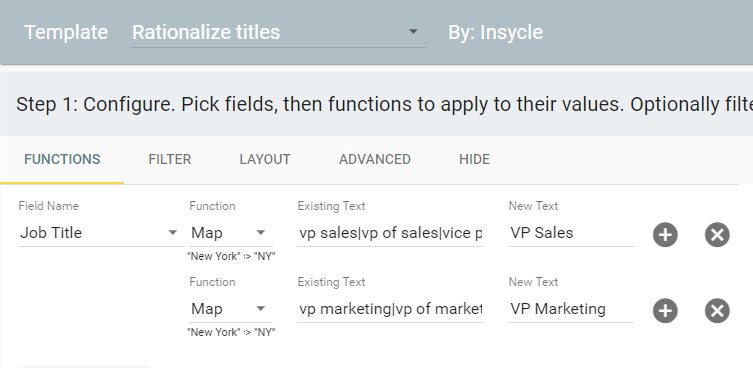
Insycle makes it simple to fix and standardize issues like this quickly in bulk, or automatically on an ongoing basis so you never have to deal with these issues again.
Insycle includes dozens of pre-built templates for fixing common data issues. As soon as you sign up for a free trial, Insycle begins auditing your customer data and generates your Customer Data Health Assessment, which will identify and guide you toward the right tool to fix common customer data errors in your Mailchimp database.
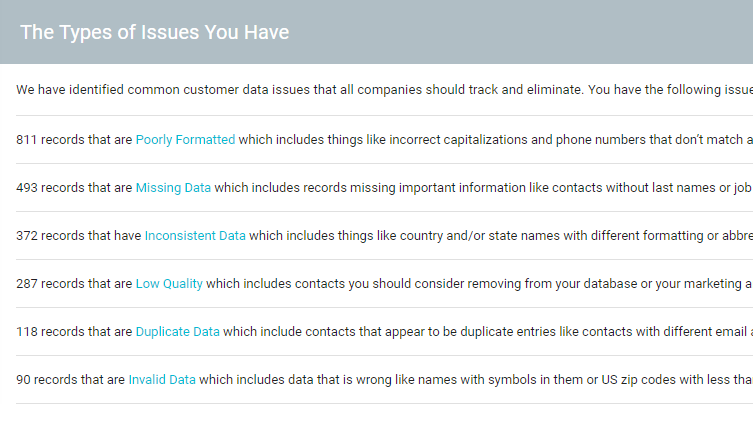
As we covered earlier, a common issue with subscriber data is typos in the subscriber email address — like jane@gmail.com vs. jane@gmil.com. Insycle can automatically detect subscribers with likely-typos in their email field and help you to fix them in bulk. Your ‘cleaned’ Mailchimp contacts may contain many email addresses that included typos.
You can also create your own custom templates, using any field in your database, and add it to your Customer Data Health Assessment to surface issues that are unique to your company.
Declutter Your Mailchimp Database By Purging Garbage Data
For some of your Mailchimp records, the data is simply not usable. Either the information is fake, full of errors, or is simply inaccurate. These are records that can never be cleansed using any system and it would make more sense to purge them entirely.
Insycle makes it easy to identify garbage, purgeable data in Mailchimp using advanced filtering, using multiple variables.
For instance, you could filter your data to find records that:
- Use a free email address
- Do not contain a first name
- Have not opened an email from you for six months or more
What constitutes “garbage data” will be different in every organization and may depend on the custom fields that you collect from subscribers. Generally, you only want to remove data that is completely unusable.
Garbage data should be removed from your database as quickly as possible. It can impact your deliverability by increasing bounce rates, lowering open rates, and increasing the risk of personalization errors, and therefore potentially spam reports, in the email campaigns that you send.
Learn more about this in this article: Declutter Your CRM By Purging Low-Quality Data Automatically
Preview All Changes Before They Go Live
Insycle is incredibly powerful, allowing you to cleanse, standardize, and purge data in bulk. But, you want to make sure that you are only affecting records in the way that you want, with no unwanted changes being applied to your Mailchimp subscriber records. You can send marketing campaigns in peace.
Any changes that you make using Insycle can be previewed before they go live in your Mailchimp database, so you’ll never have to worry about unwanted changes being made to your data.
After running a data update template, you’ll be taken to a 3-step process that will allow you to preview or run, set up email notifications, and automate the
You can also generate a .CSV of this preview so that you can share it with others who can double-check the work along with you. You can share it automatically with anyone in your organization and personalize your messaging to provide directions.
Automate Routine Data Management Tasks
Have you ever tried to fix data errors in your Mailchimp database? If you have, you probably know what a pain it can be.
You either have to edit your subscriber records one-by-one inside of Mailchimp, which can take hours, or export the data and work on it using complicated Excel functions, before importing it back into your database.
Often, routine data management tasks have to be completed on a weekly or monthly basis to keep your contact data clean. But that can amount to a lot of time spent working on these issues.
Insycle helps to eliminate all of that mundane data work.
Using Insycle, you can cleanse data, standardize it, and deduplicate Mailchimp contacts across audiences — automatically and on a set schedule.
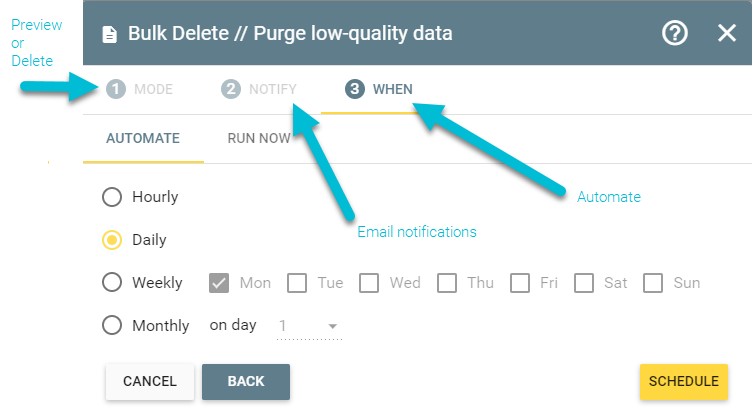
Insycle — A Marketer’s Ally for Cleansed Mailchimp Data
Insycle is a complete data management and cleansing solution for Mailchimp, making it easy to deduplicate, cleanse, and standardize your data regularly, on a set schedule.
Instead of repeatedly exporting your Mailchimp data, fixing it in Excel using complicated functions and VLOOKUP, and then importing it back — Insycle makes it easy to automate repetitive data tasks that take up your marketing team’s valuable time while improving your personalization, email deliverability, and marketing campaigns as a whole.
Looking to simplify the process of managing Mailchimp duplicates and put deduplication on autopilot? Start a free trial today by clicking the “Free Trial” button in the top right of your screen.
